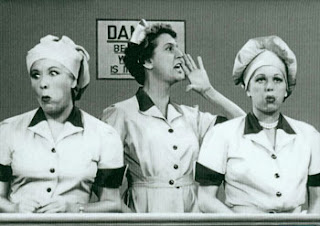Chocolate Bunnies
Beth’s office is heaven for a candy lover. From the vintage gumball machine on the shelf in the hallway to the candy-themed graphic prints, just about every candy-related item you could wish for is lurking in some corner. For example, in the middle of work on Monday afternoon Beth pulled out an entire basket full of antique tin chocolate molds. Looking through them I realized many of the molds were Easter themed. It turns out the first edible bunnies were found in Germany in the 1800s and Whitman’s Chocolates was one of the first to produce chocolate bunnies in the United States in 1842, but these adorable chocolate confections didn’t gain popularity until the 1900s. Now we see them everywhere from February through April. So what better time to learn how to make molded chocolates than for a holiday that evokes childhood memories of biting the ears off countless chocolate bunnies?
The brunt of the work when it comes to making chocolates of any kind is the process of tempering the chocolate. Chocolate’s main components are cocoa solids, cocoa butter, sugar and an emulsifier (often soy lecithin). Milk chocolate also contains milk powder and white chocolate contains no cocoa solids. If you’ve ever seen any kind of chocolate with a white powdery surface you’ve seen chocolate out of temper or “bloomed”. This means that cocoa butter is no longer evenly crystallized and distributed throughout the chocolate and has risen to the surface. Tempering the chocolate prevents the cocoa butter from “blooming”. Tempering also helps the chocolate set properly and results in a shiny hard surface.
Tempering:
- To temper chocolate place the amount of chocolate you need (I usually melt about one pound) in a metal bowl on top of a pot of hot water. Make sure the water does not touch the bottom of the bowl.
- Allow the chocolate to melt, stirring occasionally and using a chocolate thermometer to keep track of the temperature.
- While the chocolate is melting take an equal amount of the same chocolate and cut it into small pieces (about the size of M&Ms) and set aside.
- When the melting chocolate reaches between 110 and 120 degrees Fahrenheit take the bowl off the heat, making sure to wipe the bottom of the bowl clean of condensation (if water gets inside the bowl it will contaminate the chocolate and ruin the temper).
- Add a handful of the small chocolate pieces to the melted chocolate and stir until they have melted. Measure the temperature of the chocolate.
- Repeat the same process until the temperature of the chocolate has reached 85 degrees.
- Then place the bowl back on the pot without turning the burner on and carefully monitor the chocolate with the thermometer until it reaches between 87 and 91 degrees for bittersweet and semisweet chocolate and between 84 and 88 degrees for white or milk chocolate. This can happen in a matter of seconds.
- At this point the chocolate is ready to be used. Continue to occasionally check the temperature of the chocolate while working with it and put it back on the heat source if the temperature drops. If the chocolate is too thick to work with, heat it up a few degrees and cool it back down again by stirring.
Molding:
In case you don’t already own a chocolate mold, there are lots of chocolate molds out there in stores and on the Internet but one source I trust to give me good quality molds. Make'n Mold has a big assortment of well-made molds. Once you have a mold, the first step in molding chocolates is to make sure the molds are clean. Chocolate molds (whether vintage or brand new) should never be cleaned with any abrasive material and should be washed with only hot water. Buff the molds clean with cotton before using. Using a ladle, spoon tempered chocolate into the mold, tilting it to make sure the chocolate covers all the crevices. Tap the mold against a table several times to get rid of any air bubbles. Depending on the mold, you might be making a solid chocolate or a two-sided hollow chocolate. For a solid chocolate, fill the mold to the top and use an offset spatula on top of the mold to get rid of excess chocolate (so that the backs of the chocolates are flat). For a hollow chocolate like the rabbits I used, tip the mold so that excess chocolate drains and then remove excess chocolate around the edges of the mold with an offset spatula in the same way as for the solid chocolates.
Once the molds have been filled let them set until the chocolate is hard (at this point you might also be able to see the chocolate pulling away from the sides). The chocolate contracts as it hardens and releases from the mold when gently tapped upside down. If you used a two-sided mold like the antique ones I found, use a little tempered chocolate to glue the two sides together. At this point all you have to do is enjoy your delicious molded chocolate!
Good luck!



Oh wow, these look great! Cool!
ReplyDelete